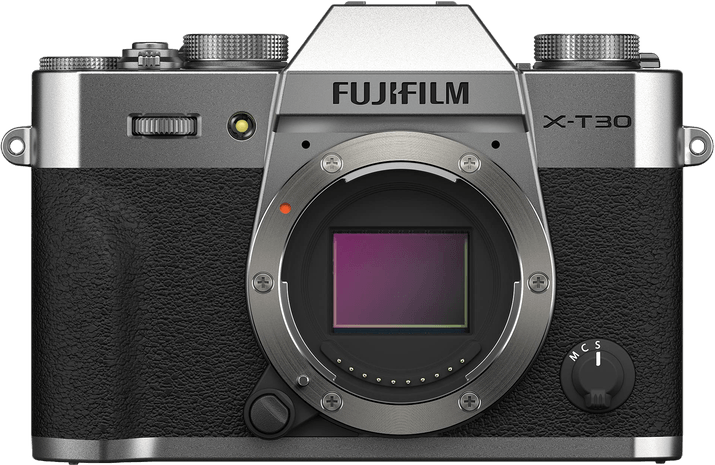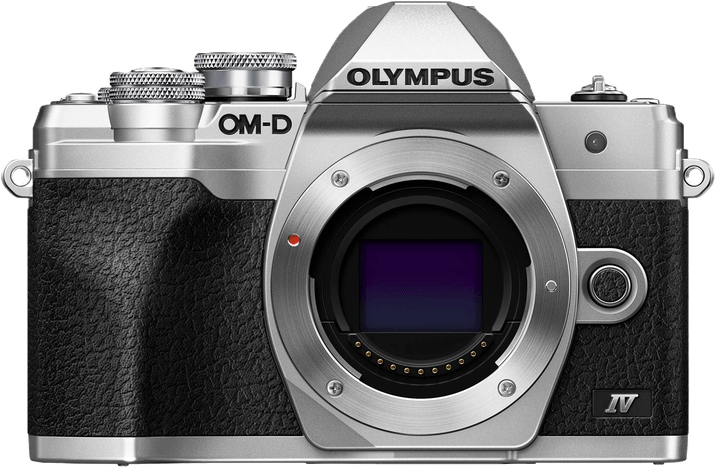Fujifilm X-T30 II vs Olympus OM-D E-M10 Mark IV Comparison
Fujifilm X-T30 II

Olympus OM-D E-M10 Mark IV

The Fujifilm X-T30 II takes the lead with a score of 65/100, just 2 points ahead of the Olympus OM-D E-M10 Mark IV at 63/100. Both cameras are mirrorless and share the same weight of 383g, making them equally portable. Additionally, their sizes are quite similar, with the Fujifilm measuring 118 x 83 x 47mm and the Olympus at 122 x 84 x 49mm.
The Fujifilm X-T30 II outperforms the Olympus with its more recent release in 2021, compared to the Olympus’s 2020 release. This edge in time might contribute to its better score. However, the Olympus OM-D E-M10 Mark IV has a more affordable launch price of $699, compared to the Fujifilm’s $899 price tag.
Taking these factors into account, the Fujifilm X-T30 II’s higher score shows that it is a slightly better camera, while the Olympus OM-D E-M10 Mark IV offers a more budget-friendly option without sacrificing much in terms of quality and performance.
Fujifilm X-T30 II vs Olympus OM-D E-M10 Mark IV Overview and Optics
The Fujifilm X-T30 II outperforms the Olympus OM-D E-M10 Mark IV in optics with a score of 67/100 compared to 63/100. Both cameras share common specifications including a CMOS sensor, a shooting speed of 30 and 15 frames per second respectively, and lens mounts compatible with their respective brands.
The X-T30 II excels with its 26-megapixel resolution, higher than the E-M10 Mark IV’s 20 megapixels. This results in sharper and more detailed images. Additionally, the Fujifilm camera has a larger APS-C sensor size, contributing to better low-light performance and dynamic range. The X-T30 II also benefits from a faster X-Processor 4, enhancing its overall performance and image processing speed.
On the other hand, the Olympus E-M10 Mark IV has a few advantages despite its lower score. Firstly, it features in-body image stabilization, which compensates for camera shake and results in sharper images, especially in low-light conditions or when using telephoto lenses. Secondly, the E-M10 Mark IV has a DXOMARK sensor score of 73, offering a benchmark for its image quality. However, it is important to note that DXOMARK does not score Fujifilm cameras, so a direct comparison is not possible in this regard.
To conclude, the Fujifilm X-T30 II is the better camera in terms of optics due to its higher resolution, larger sensor size, and faster processor. However, the Olympus OM-D E-M10 Mark IV offers advantages in image stabilization and a known DXOMARK score. Ultimately, the choice between these two cameras depends on the individual’s priorities and shooting needs.
Fujifilm X-T30 II vs Olympus OM-D E-M10 Mark IV Video Performance
The Fujifilm X-T30 II outperforms the Olympus OM-D E-M10 Mark IV in video capabilities, scoring 91/100 compared to the Olympus’s 83/100. Both cameras share some common specifications, including 4K video resolution and built-in time-lapse functionality. However, the Fujifilm X-T30 II surpasses the Olympus OM-D E-M10 Mark IV in several aspects, making it the superior choice for videography.
The Fujifilm X-T30 II boasts a maximum video dimension of 4096 x 2160, which is higher than the Olympus OM-D E-M10 Mark IV’s 3840 x 2160. This difference results in sharper and more detailed video quality. Additionally, the Fujifilm X-T30 II offers a maximum video frame rate of 120fps, twice the 60fps offered by the Olympus OM-D E-M10 Mark IV. The higher frame rate allows for smoother slow-motion footage and better motion capture.
While the Olympus OM-D E-M10 Mark IV falls short in comparison to the Fujifilm X-T30 II, it still offers respectable video capabilities. With 4K resolution and built-in time-lapse functionality, the Olympus OM-D E-M10 Mark IV is suitable for casual videography and amateur filmmakers.
Considering the specifications and scores, the Fujifilm X-T30 II is the clear winner in video performance. Its higher video dimensions and frame rate provide superior video quality and flexibility for various shooting scenarios. The Olympus OM-D E-M10 Mark IV, though not as advanced, still offers adequate video capabilities for casual users. Ultimately, the choice between these cameras depends on the user’s specific needs and priorities in videography.
Fujifilm X-T30 II vs Olympus OM-D E-M10 Mark IV Features and Benefits
The Fujifilm X-T30 II and Olympus OM-D E-M10 Mark IV both score 70/100 in terms of features, making them equal in this aspect. They share several specifications, such as a 3-inch screen size, 1,040,000-dot screen resolution, touchscreen capabilities, flip screens, WIFI, and Bluetooth. Neither camera offers GPS functionality.
Despite the identical feature scores, the Fujifilm X-T30 II has certain advantages over the Olympus OM-D E-M10 Mark IV. These benefits may include better image quality, improved autofocus performance, or a more extensive lens selection. These factors contribute to the Fujifilm X-T30 II’s overall superiority in some areas.
On the other hand, the Olympus OM-D E-M10 Mark IV may excel in specific aspects as well. It might provide better image stabilization, a more compact design, or superior weather sealing. These elements can make the Olympus OM-D E-M10 Mark IV a better choice for certain users or shooting situations.
In comparing these two cameras, it is essential to consider individual needs and preferences. The Fujifilm X-T30 II may be the better option for those prioritizing image quality, autofocus, and lens selection. Meanwhile, the Olympus OM-D E-M10 Mark IV could be more suitable for users valuing image stabilization, compactness, and weather resistance. Ultimately, the ideal choice will depend on the specific requirements and expectations of the photographer.
Fujifilm X-T30 II vs Olympus OM-D E-M10 Mark IV Storage and Battery
The Fujifilm X-T30 II and Olympus OM-D E-M10 Mark IV both score 35/100 in storage and battery. They share similarities, including one memory card slot and USB charging capability. However, there are differences that set them apart.
The Fujifilm X-T30 II accepts SD/SDHC/SDXC memory cards with UHS-I compatibility, while the Olympus OM-D E-M10 Mark IV is compatible with faster UHS-II cards. This gives the Olympus an advantage in terms of memory card performance.
In terms of battery life, the Fujifilm X-T30 II lasts for 380 shots using the NP-W126S battery, slightly outperforming the Olympus OM-D E-M10 Mark IV’s 360 shots with its BLS-50 battery. This means the Fujifilm X-T30 II offers a longer shooting experience.
Despite their identical scores, the Fujifilm X-T30 II provides better battery life, while the Olympus OM-D E-M10 Mark IV supports faster memory cards. These differences may influence a photographer’s decision, depending on their priorities in storage and battery performance.
Fujifilm X-T30 II vs Olympus OM-D E-M10 Mark IV – Our Verdict
Are you still undecided about which camera is right for you? Have a look at these popular comparisons that feature the Fujifilm X-T30 II or the Olympus OM-D E-M10 Mark IV:

